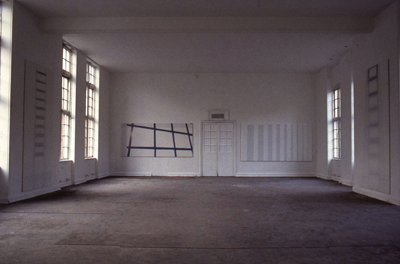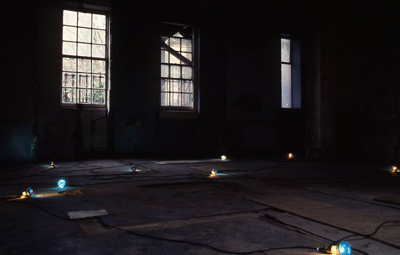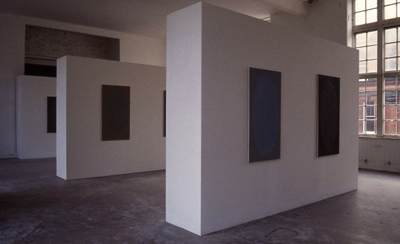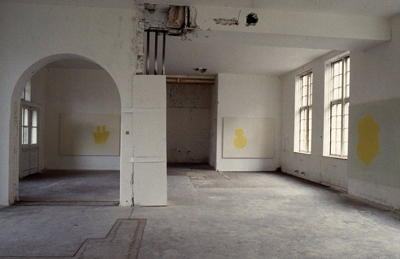Affective Light
In the Light of Questions of Place – Lewis Johnson
Rear Window Publications
1993 © Lewis
Johnson.
“The fixed image knows no repose, and this above all because it poses nothing, establishes nothing. Its fixity, like that of the corpse, is the position of what stays with us because it has no place.” ( Maurice Blanchot, “The Two Versions of the Imaginary,” trans. Anne Smock, in The Space of Literature (Lincoln: Nebraska University Press, 1982), p. 259.)
No repose, no resting place; the image, the fixed image, as token of the impossibility of being fixed? How is this the case? Is not the image always the agent of a fixing, a taking form? “For the subjective apprehension, for the spectator,” said Hegel of representational painting, the image thus the agent of being fixed, of a sitting of the spectator:
“The spectator is as it were in it from the beginning, is counted in with it, and the work exists only for this fixed point, i.e. for the individual apprehending it.” (G.W.F. Hegel, Aesthetics: Lectures on Fine Art (1818-1831), 2 Vols., trans. T.M. Knox (Oxford: Oxford University Press, 1975), Vol. 2, p. 806.)
We might imagine someone trying to signal to others, as they stand before a painting in a gallery, perhaps having adjusted their position to diminish the effects of reflected light, to see what appears there as if he or she might occupy the space of which that other, represented space were a part, that the spectator had taken up their place and were not to be interrupted. Being sited by the image would thus be part of a struggle, a struggle to retain position, being positioned, against others seeking to be positioned, or just against being deposed.
As Blanchot suggests, this process of trying to take a hold of the image to make it “serve the world’s truths” requires, if this struggle for position is to be deferred, a detour through what the image appears to represent. The image is thus determined as showing us how we may have command over the objects represented therein, if only as elements in a play of signification, the effects of meaning to which they have been subjected, by means of which we may seek a certain education of our desires:
“The image becomes the object’s aftermath, that which comes later, which is left over and allows us to have the object a our command when there is nothing left of it.” (Blanchot, p. 260.)
The image is thus constituted, ideally, as a non-object, as the site of the residue of objects. Agreed on like this, the image would thus serve to form a melancholy community, one which identified that residue as the occasion for peace and as the end of the struggle. Paintings would thus find their inevitable, somewhat privileged place as pathetic witnesses to this in the care of curators and conservators, trying to keep the fixed image fixed, trying to give the viewing public the fix, renewing the possibility of an end of our desires.
Perhaps, following Hegel again, there may be admitted another prospective identity for painting, one which we may most easily identify with the abstract and which might seem to comprehend some of the works in this exhibition:
“The visibility and the rendering visible which belongs to painting have their differences in a more ideal form, in the several kinds of colour and they liberate art from the sensuous completeness in space which attaches to material things, by restricting themselves to a place surface.” (Hegel, “Introduction,” Vol. 1, p. 124.)
This destiny for painting, within a perspective of the ideal, would be one of the rendering visible perhaps of the “several kinds of colour,” perhaps of things themselves, becoming a cipher of a point of rest beyond sensuous completeness. Perhaps the tradition of abstract painting might seem to offer itself for comprehension along these lines, playing its part in the education of our desires mentioned above.
Yet, within these perspectives of being fixed and of transcending, there remain a number of more or less chaotic possibilities. What if the restriction “to a place surface” never quite held, was never quite accomplished? What if, within the struggle for position and for a signal of possession of objects, there were traces of a relation to existence which could not be localised, realised in some identifiable place, and which kept on insisting on dispossession?
Hence Blanchot’s analogy between the image and the corpse: not as the dispossession of the one ho has died, but of those who are left with the body which no longer corresponds to anyone. Like the corpse, the image is no longer itself; yet it stays with us, re-marking us with its effects, while remaining inaccessible.
But in what sense can an image cease to be itself? One answer, the answer of the projects of enlightenment, would be to make of it the occasion of knowledge, the topic of an enquiry into the occasion of its production and the meanings it sustains (or, as the recently current vocabulary would have it, “constructs”). As a precondition to this, however, a certain stability to the image has to be presumed so that we might reliably retrace the paths of production and discover the variations of ways, the works in Affective Light, installed in this disused hospital building, in a space without controlled and homogenising lighting often found in exhibition spaces, all play on the more or less chaotic possibilities of this non-correspondence of the image with itself, in an environment which itself carries on, in the limbo between its use as a hospital and its conversion by developers, ceasing to be itself.
2.
“The lighthouse was then a silvery, misty-looking tower with a yellow eye that opened suddenly and softly in the evening. Now—
“James looked at the Lighthouse. He could see the whitewashed rocks; the tower, stark and straight; he could see that it was barred with black and white; he could see windows in it; he could even see washing spread on the rocks to dry. So that was the Lighthouse, was it?
“No, the other was also the Lighthouse. For nothing was simply one
thing. The other was the Lighthouse too. It was something hardly to be seen
across the Bay. In the evening one looked up and saw the eye opening and
shutting and the light seemed to reach them in that airy sunny garden where
they sat.”
( Virginia Woolf, To the
Lighthouse (London: Penguin, 1977), p. 286.)
The lighthouse in Woolf’s novel is like Blanchot’s image as corpse: not present as itself, yet pervasive. More than a destination, yet like death itself, something which is represented as if to organise and regulate plans. A controlled source of light, but one which, in its constitutive intermittence, tells persistently of a loss of control of light and by extension (indeed, almost as extension, as duration as delay) of life. Established to protect and to save, the lighthouse emits its light; which seemed to reach them in that airy garden where they sat. And yet, as reminder of destruction and death, the lighthouse is also menacing; never quite the absolute guarantee of illumination, its light borrowed to serve the goals of protection, it also comes to seem to replicate the operation of looking, of wanting to see.
It is tempting to seek to identify the lighthouse and its effects with the site of this installation of works, the Henrietta Street Hospital. And if the lighthouse is never “simply one thing,” then such an effect is somewhat uncontrollable. Like the lighthouse, the institution of the hospital is evades assurance, a reminder of disease and of death. Arguments over the positioning of hospitals and their design no doubt bear traces of this. Moreover, it would be sentimental to imagine that the site, in the process of becoming some other site, was simply a benign victim. We would be sentimental to imagine that the site, in the process of becoming some other side, was simply another victim. We would be forgetting the effects of this lack of assurance, and the more micro-logical aspects of this: the desire to examine and to inspect, the aims of diagnostic vision and its technologies. Yet, despite this, the building and its site remain as a signal of a failure of the institution of hospital in this part of the city to endure and the task that remain, and will continue to remain, if such institutions are to continue, to come into being and survive.
An aspect of those tasks would thus seem to be not to let vision turn away from its desire for order and assurance and, at a certain limit, knowledge. The works installed in the old hospital building suggest a variety of directions in which vision may be de-stablised, but not so that the chaotic comes to dominate as a threat.
Brad Lochore’s paintings, perhaps at first site, suggest scenes, like the lighthouse in daylight “barred with black and white,” of which they are the traces, the aftermath of images of lucidity. Resemblances encouraged by format and by tonalities, suggest that these images might be the most reduced residue of some narrative fiction film. Yet their installation in the old hospital building, apparently risking a confusion with the site of their exhibition, might alert us to the impossibilities of establishing correspondences with inhabitable architectural spaces. The suspended umbra and penumbra of a ladder might indicate this condition of the no-longer-well-established and perhaps never-to-be-re-established place. For these paintings are derived from computer-generated images, from a place where you can produce “space that does not exist.” (From a conversation with the artist, 11/93.) Like other drawing-board procedures, such technologies bring with them possibilities of the utopian and the dystopian. Lochore’s paintings escape this opposition, however, retaining the seductions of the utopian, of the pleasures of the fictions, of the not-yet-in-place, while leaving us with an insistent sense that such narrations can never immediately provide the terms for an engagement with space and place beyond their frames.
In certain lights, passages of Jane Harris’s paintings seem the epitome of availability. In those same lights, and therefore even in the most controlled of gallery settings, the one and not quite the same surface offers up the contours of its brush marks, the rising and falling of paint, the rifts of reflected light and of shade, across the canvas over which the painter’s brush has passed. Quite how they will appear in the installation in Henrietta Street, with its variable light, remains to be seen. Indeed, so long as they survive, they will continue to remain to be seen, these paintings, which do not seem to refuse to give a figure, yet do not seem to strive so to do. As the painting as a site of having been painted insists itself, the time of viewing opens up to a time of the initial laying on of paint, a time which is and was inaccessible to vision, the initial mark the gesture which covered, obscuring even as it left something to show. In the ebbs and flows of light, perhaps these paintings, of relatively dark tonalities will be most unstable at dusk; yet they seem to invite Woolf’s “down-pouring of immense darkness,” the night in which as Woolf describes it, “there was scarcely anything left of body or mind by which one could say “This is he” or This is she.” (Woolf, p. 196.) Receptive and yet resistant to light, the paintings come to insist on the differences of what emerges to be seen, when and where and to whom.
In the perspective suggested by Blanchot’s notion of the pervasiveness
of the image, Zebedee Jone’s paintings come into view. With their scraped
surfaces and the remains of the paint, of those movements of more or less
forceful; scraping, folded around the edges of the deep and heavy stretchers,
one over another, there is a way in which any sense that one has identified
an image retreats, spreading out before us.
It seems to me as if the sense of this spreading out vary, depending on the
degree of variegation of the paint use. In the earlier paintings, the variety
of pigments leaves us with a surface in which a play of resemblances may
take place. In the later, apparently monochromatic paintings, the surface
tends to catch the light, seaming to retain it clearly, despite the use of
wax as a medium.
There are various economies of clarity to these paintings, therefore, in the earlier, variegated paintings, the layering of waves of paint over the edge tends to suggest an availability of the “history of the vents of paintings”(From a conversation with the artist, 11/93.), something which the play of resemblance disperses in the time of fantasy and in the sense of the blurring of the surface; in the later monochrome paintings, the marks which inscribe the surface, marks of brush and of other, flatter instruments tend to deflect the eye form the reflected light, and leaded over the surface and to the edges where its movement tends to exceed the traces of the flows of paint.
There is thus a shift from the apparently enigmatic to the apparently un-enigmatic, the apparently monochrome. This controlled release of the eye occurs because, as the painter has it, “the painting itself makes the image.” (From a conversation with the artist, 11/93.) This release of the eye, away from the play of resemblances, and towards a confidence about the history of the events of paintings, is all the more insistent in suggesting that there is something here which cannot be identified by the eye, “no image semblance of serving… comes readily to hand.” (From a conversation with the artist, 11/93.)
The paintings by Joan Key to be shown in the old hospital building produce rather different effects. One of them offers a cross-like figure in yellow as if dispersing in the cream colour, which surrounds and envelops it. This image is all the more uncanny in its resemblance to an emblem of health care by virtue of the dispersed nature of that figure. In her other paintings, the strangely dark and sometimes dull, sometimes very luminous appearances f the yellow pigment play with the eye’s movements in space, seeming to upon up the volume of the space around to a mobility of looking and seeing. The eye is drawn and perhaps reoriented by the yellow isolated in the expanses of cream; turned to move out through the yellow and across the cream, accelerating. The uncanniness of the resemblance of the small cross-like figure is thus one among a numerable possibilities of uncanny resemblance: uncanny not least because the eye is encouraged in the movement and thus all the more struck by resemblance. NO doubt there are several connotations, which will move to the fore in the installation of these paintings in the old hospital building, among them those of play and of the incapacity to play. But these connotations do not simply depend on such a space. Remarkable about these paintings is the sense that, despite the way in which the qualities of pigment, particularly the strangely dark yellow are varied, this concern with matter does not preclude play. Such play, not simply an indifferent shifting through space, as the resemblance to the emblem suggest here, recalls something of the process described by Woolf as follows:
“Phrases came. Vision came. Beautiful pictures, Beautiful phrases. But what she wishes to get hold of was the very jar of the nerves, the thing itself before it has been made anything.” (Woolf, p. 199)
Such a sense of play, of appearances with the sense of sight, suggests a perspective in which one would not just assent to the loss of a hospital, the loss of a correspondence of an emblem, but in which one would find an energy to refigure and figure again.
Finally, the piece by David Ward or rather a reworking of a piece. The installing in each of the windows of the façade of that hold hospital building of a blue light bulb, illuminated gradually as the daylight withdraws and dimmed as the daylight returns, going out with the dawn, has more in common with that sense of the image that Blanchot outlines than a restrictive interpretation of his notions as applying solely to painting, or to any other particular image making process, would suggest. “What stays with us because it has no place”: because of the very positioning of the light bulbs, in the windows of the façade of a building which no longer corresponds to the place of that hospital, David Ward’s piece suggests a controlled overflow of the image, one which both falls short of and exceeds the illumination of the façade. Not the traditional illumination of the “son and lumière,” with the depth of the façade disappearing into an image, before which an audience might take up a position ready for instruction and for entertainment; but a play of light in the depth of the façade, in the space of its existence. That existence is rendered remarkable as temporary: the switching on of the lights, soliciting a look which might expect the night to be overcome for he sale of illumination, remains both discontinuous with the departure and return of sunlight and yet not disharmonious with the night, the blue of the lights emerging as a reminder of its colour. This notion of a reminder goes further: a reminder of the space of the site, even while the building is inaccessible, which in turn recalls the closing of that hospital itself. This piece and its reworking thus rejoining Blanchot’s notion of something which “stays with us because it has no place”: neither ideally separable from place nor presuming on a security of place, which suggests how we might be moved by the apparently placeless.







